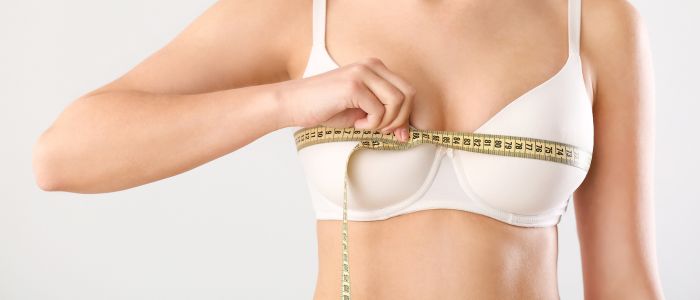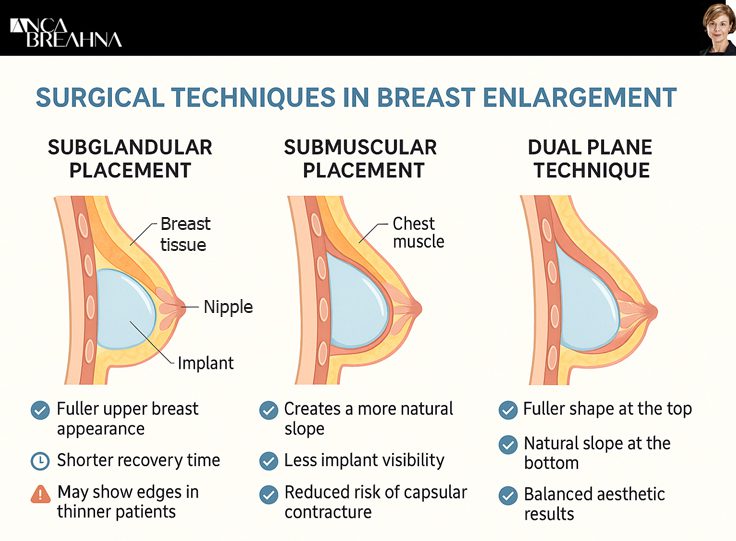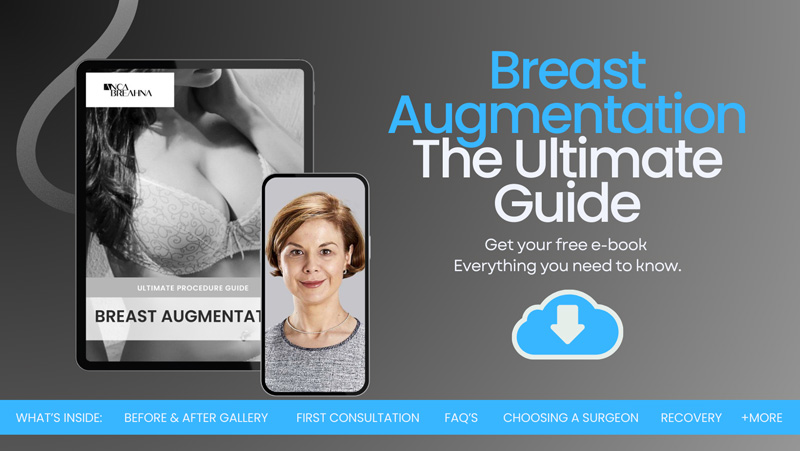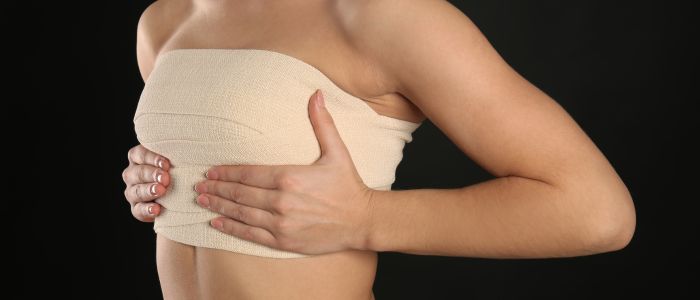
The Latest Trends in Surgical Approaches for Breast Augmentation in 2024
As you consider enhancing your figure, it’s important to stay informed about the most current surgical approaches that prioritise both aesthetics and safety. This year, we’ve observed significant advancements in techniques that offer more natural, personalised results. In this blog, we will discuss the latest insights on breast augmentation trends in 2024 presented by Consultant Plastic Surgeon Anca Breahna. Whether you’re contemplating your first procedure or considering an update, understanding these trends will help you make a well-informed decision that aligns with your goals.
Take our Plastic Surgery Quiz to find out if you’d be a good candidate for cosmetic surgery.
Popular Breast Augmentation Trends in 2024
1. Minimally Invasive Techniques
Minimally invasive techniques in breast augmentation have significantly transformed the surgical landscape, offering patients the advantages of reduced recovery times, minimal scarring, and overall improved comfort and outcomes. These advancements are highly favoured by both patients and surgeons, marking a shift towards more sophisticated and patient-friendly procedures.
- Reduced Recovery Times: Traditional breast augmentation surgery often entails a lengthy recovery period, during which patients may experience significant discomfort, pain, and restricted mobility. Minimally invasive techniques, such as endoscopic breast augmentation, involve smaller incisions and less tissue disruption. This approach not only minimises postoperative pain but also shortens the overall recovery time, allowing patients to return to their normal activities more quickly. Patients can typically resume light activities within a week and fully recover within a few weeks, compared to the months it might take with more invasive procedures.
- Minimising Scarring: One of the main concerns for many patients considering breast augmentation is the potential for noticeable scarring. Minimally invasive techniques address this concern by using smaller incisions placed in less conspicuous locations, such as the underarm or the natural crease beneath the breast. These strategic incision sites help to minimise visible scarring, ensuring a more aesthetically pleasing outcome. Advances in surgical tools and methods also contribute to more precise and cleaner incisions, further reducing the risk of prominent scars.
- Improved Comfort and Outcomes: The use of advanced technologies, such as fibre-optic cameras and specialised surgical instruments, allows surgeons to perform breast augmentation with greater precision and control. This results in less trauma to the surrounding tissues, reducing inflammation and pain post-surgery.
- Technological Advancements: The integration of cutting-edge technologies, such as 3D imaging and computer-assisted surgical planning, has revolutionised the approach to breast augmentation. These tools enable surgeons to create detailed surgical plans tailored to each patient’s unique anatomy, ensuring optimal implant placement and symmetry. Patients can also visualise potential outcomes before the surgery, enhancing their confidence in the procedure and satisfaction with the results.
2. Inframammary Fold Incision
The inframammary fold incision, made under the breast at the natural crease where the breast and chest meet, has gained significant popularity due to its various advantages. This technique offers several benefits that make it a preferred choice for both patients and surgeons seeking effective and aesthetically pleasing outcomes.
- Minimal Scarring: The inframammary fold incision is strategically placed in the natural crease beneath the breast, which effectively conceals the scar. Over time, as the scar heals, it becomes less noticeable, blending seamlessly with the natural skin folds. This placement ensures that the scar is hidden even when wearing low-cut tops or swimwear, providing patients with greater confidence in their appearance.
- Excellent Access and Precision: One of the primary reasons for the popularity of the inframammary fold incision is the superior access it provides to the surgical area. This incision allows the surgeon to have a direct view of the breast pocket, enabling precise placement of the implant. The improved visibility reduces the risk of complications, such as implant malposition or asymmetry, and ensures a more accurate and aesthetically pleasing outcome.
- Versatility with Implant Types: The inframammary fold incision is compatible with various types of implants, including silicone and saline. It is particularly advantageous for the placement of silicone implants, which are pre-filled and require a slightly larger incision for insertion. This technique also allows for the use of different implant shapes and sizes, giving patients a wide range of options to achieve their desired breast contour and volume.
- Reduced Risk of Complications: Compared to other incision types, the inframammary fold incision is associated with a lower risk of certain complications. For instance, the risk of capsular contracture, a condition where scar tissue forms around the implant, is reduced with this approach. Additionally, the inframammary fold incision has a lower likelihood of interfering with breastfeeding, as it avoids the milk ducts and glandular tissue.
- Postoperative Care and Healing: The inframammary fold incision typically results in a straightforward healing process. Patients are advised to follow their surgeon’s postoperative care instructions meticulously, which may include keeping the incision site clean, avoiding strenuous activities, and wearing a supportive bra. Most patients find that any discomfort subsides within a few days to a week, and they can return to their normal activities relatively quickly.

3. Submuscular Implant Placement
Submuscular implant placement, where the breast implant is positioned beneath the pectoral muscle, has become increasingly popular due to its numerous benefits. This technique is favoured for its ability to provide a more natural appearance and reduce the risk of certain complications.
- Natural Appearance and Feel: One of the primary advantages of submuscular implant placement is the natural look and feel it provides. By placing the implant beneath the muscle, the edges of the implant are less visible, and the overall contour of the breast appears smoother and more natural. This technique is particularly beneficial for women with little natural breast tissue, as the muscle provides additional coverage, resulting in a more subtle and realistic enhancement.
- Reduced Risk of Capsular Contracture: Capsular contracture, a condition where scar tissue forms around the implant and causes it to harden, is a concern for many breast augmentation patients. Submuscular placement is associated with a lower risk of this complication. The movement of the pectoral muscle helps to prevent the formation of excessive scar tissue around the implant, reducing the likelihood of capsular contracture and ensuring a softer and more natural feel to the breast.
- Improved Mammogram Readings: Another significant benefit of submuscular implant placement is its positive impact on mammogram readings. When the implant is placed beneath the muscle, it is less likely to interfere with mammographic imaging, allowing for clearer and more accurate breast cancer screenings. This is an important consideration for women who are concerned about maintaining effective breast health monitoring after augmentation.
- Better Support and Stability: The pectoral muscle provides additional support and stability to the breast implant, helping to maintain its position over time. This reduces the risk of implant displacement or bottoming out, where the implant shifts downward. The muscle’s support also contributes to a more youthful and perky breast appearance, which can be particularly beneficial for women with sagging or drooping breasts.
- Recovery and Postoperative Care: While the recovery process for submuscular implant placement may be slightly longer than for subglandular placement, many patients find that the benefits outweigh the additional recovery time. Patients may experience some muscle soreness and tightness in the chest area, which typically subsides within a few weeks.
4. Fat Transfer Augmentation
Fat transfer augmentation, also known as autologous fat grafting, is a technique in breast augmentation that utilises the patient’s own body fat to enhance breast volume. This method is gaining popularity due to its natural results and dual benefits of body contouring and breast enhancement.
- The Process of Fat Transfer: The procedure involves two main steps. First, liposuction is performed to harvest fat from areas of the body with excess fat deposits, such as the abdomen, thighs, or flanks. This fat is then purified and carefully injected into the breasts to achieve the desired volume and shape. The use of the patient’s own fat reduces the risk of allergic reactions or rejection, making it a safer alternative to synthetic implants.
- Natural Look and Feel: One of the most significant advantages of fat transfer augmentation is the natural look and feel it provides. Since the enhancement is achieved using the patient’s own fat, the breasts tend to have a more natural texture and appearance compared to synthetic implants. This method is ideal for patients seeking subtle to moderate increases in breast size or those looking to correct asymmetry or contour irregularities.
- Dual Benefits of Body Contouring: In addition to enhancing the breasts, fat transfer augmentation offers the added benefit of body contouring. The liposuction procedure used to harvest fat helps to sculpt and tone the donor areas, resulting in a more balanced and proportionate figure. Patients often appreciate the combined effects of fat reduction in problem areas and a fuller, more shapely bust.
- Long-term Results: Fat transfer augmentation can provide long-lasting results, though some of the injected fat may be reabsorbed by the body over time. Typically, about 60-80% of the transferred fat survives and becomes a permanent part of the breast tissue. To ensure optimal results, surgeons may slightly overfill the breasts initially to account for this natural reabsorption. Patients should maintain a stable weight to preserve the longevity of their results, as significant weight fluctuations can affect the size and shape of the augmented breasts.
- Suitability for Different Patients: Fat transfer augmentation is suitable for a wide range of patients, particularly those who prefer a natural enhancement without the use of synthetic materials. It is also an excellent option for patients who have experienced complications with traditional implants or those who desire a more modest increase in breast size. However, candidates must have sufficient fat stores in other areas of their body to be eligible for the procedure.
- Recovery and Postoperative Care: The recovery period for fat transfer augmentation is generally shorter and more comfortable compared to traditional implant surgery. Patients may experience some swelling and bruising in both the liposuction and injection sites, but these symptoms typically subside within a few weeks.
5. Combination Procedures
Combination procedures in breast augmentation involve integrating additional surgical techniques to enhance both the size and shape of the breasts, providing comprehensive aesthetic improvements. These procedures are increasingly popular as they offer a holistic approach to body contouring and rejuvenation.
- Breast Augmentation with Lift (Augmentation Mastopexy): One of the most common combination procedures is breast augmentation with a lift. This procedure addresses both volume enhancement and sagging, resulting in fuller, perkier breasts. During the surgery, implants are inserted to increase breast size, while excess skin is removed, and the breast tissue is lifted and reshaped to create a more youthful contour. This dual approach is particularly beneficial for women who have experienced significant weight loss or post-pregnancy changes that affect breast volume and position.
- Liposuction and Breast Augmentation: Combining liposuction with breast augmentation allows for simultaneous body sculpting and breast enhancement. Fat removed from areas such as the abdomen, thighs, or flanks can be used for fat transfer to the breasts, achieving a natural augmentation. Alternatively, traditional implants can be used while liposuction sculpts and refines other areas of the body. This approach helps to create a balanced and harmonious silhouette, enhancing the overall aesthetic outcome.
- Tummy Tuck and Breast Augmentation (Mummy Makeover): The “mummy makeover” is a popular combination procedure that typically includes a tummy tuck (abdominoplasty) and breast augmentation. This complex approach addresses the physical changes that many women experience after pregnancy and childbirth, such as loose abdominal skin and deflated breasts. By combining these procedures, patients can achieve a flatter abdomen and fuller breasts in one surgical session, reducing overall recovery time and providing dramatic, transformative results.
- Breast Augmentation with Fat Grafting: As discussed earlier, fat transfer can be used alone for breast augmentation or in combination with implants to enhance the overall result. Fat grafting can smooth the edges of implants, correct contour irregularities, and provide additional volume in specific areas, creating a more natural and seamless appearance. This combination is particularly useful for patients who require reconstruction or have asymmetrical breasts.
Download the Breast Augmentation Guide

The primary advantage of combination procedures is the ability to address multiple aesthetic concerns in a single surgery. This approach not only enhances the overall result but also reduces the need for multiple surgeries, lowering the associated risks and recovery times. Patients benefit from a more cohesive and balanced appearance, as the procedures are planned and executed with a holistic view of the body’s proportions and contours.
While combination procedures offer numerous benefits, they also require careful planning and consideration. The complexity of performing multiple procedures simultaneously increases the duration of surgery and the potential for complications. Patients must be in good overall health and have realistic expectations about the outcomes.
Recovery from combination procedures can be more extensive compared to single procedures, as multiple areas of the body are healing simultaneously. Patients may need to follow a more complex postoperative care plan, including specific instructions for each surgical site. Pain management, proper wound care, and activity restrictions are crucial for a smooth recovery and optimal results.
FAQs about Breast Augmentation Trends in 2024
What are the most common reasons women choose to undergo breast augmentation?
- Women opt for breast augmentation for various reasons, including enhancing their body contour, restoring breast volume lost after weight loss or pregnancy, correcting asymmetry, and boosting self-confidence. Some seek to improve the balance of their figure, while others aim to achieve a more youthful appearance.
How long do breast implants typically last before needing replacement?
- Breast implants are not lifetime devices, and many factors can influence their longevity. On average, implants may last between 10 to 20 years. However, some patients may need to replace their implants sooner due to complications, changes in aesthetic preferences, or natural aging processes. Regular follow-up with a plastic surgeon can help monitor the condition of the implants.
What are the risks associated with breast augmentation surgery?
- Like any surgical procedure, breast augmentation carries risks. Potential complications include infection, bleeding, scarring, implant rupture or leakage, capsular contracture, and changes in nipple or breast sensation.
How should one prepare for breast augmentation surgery?
- Preparation for breast augmentation surgery involves several steps. Patients should have a thorough consultation with their surgeon to discuss goals, options, and risks. Preoperative instructions often include avoiding certain medications, stopping smoking, and arranging for post-surgery care. It’s also beneficial to maintain a healthy lifestyle, including proper nutrition and hydration, to promote optimal healing.
Further Reading about Breast Augmentation with Consultant Plastic Surgeon Anca Breahna
- Read more about How to Get a Natural Looking Breast Augmentation Using Smaller Implants
- Read more about Breast Augmentation with Mentor Breast Implants
- Read more about All about Perfect Breasts and How to Get Them
- Read more about Natural Boob Job – Autologous Fat Transfer to the Breasts
- Read more about How to Fix Saggy Breasts – Breast Uplift, Breast Implants or Both
- Read more about 10 Myths Busted about Breast Augmentation and Breastfeeding
- Read more about Preparing for Breast Augmentation: A Checklist
- Read more about Injectables vs. Surgery
- Read more about Breast Augmentation Size Chart – Implant Sizes and UK Bra Cup Sizes
- Read more about How Breast Augmentation Can Affect Your Posture and Back
Medical References about Breast Augmentation Trends
- Evolving Trends in Cosmetic Breast Augmentation: New Data – ASPS
- Trends in Breast Augmentation Research
- Trend watch: Are more patients getting explants and returning to a more natural look? – ASPS
- A new era of confidence: Patient perspective in breast augmentation – ASPS
- The art and science of breast augmentation: How to choose the right surgeon and implant size for your unique goals – ASPS


 Ms Anca Breahna, PhD, MSc, FEBOPRAS, FRCS (Plast) is a highly regarded Consultant Plastic Surgeon specialising in the field of Aesthetic and Reconstructive Plastic Surgery. Anca performs a range of
Ms Anca Breahna, PhD, MSc, FEBOPRAS, FRCS (Plast) is a highly regarded Consultant Plastic Surgeon specialising in the field of Aesthetic and Reconstructive Plastic Surgery. Anca performs a range of 